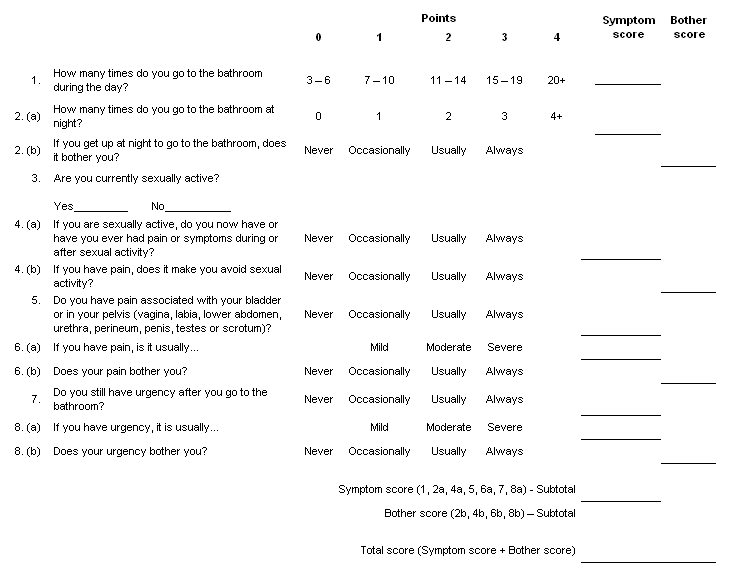Monitoring
Patients should be followed up at 6 weeks with a Pelvic Pain and Urgency/Frequency (PUF) Questionnaire score to monitor improvement and symptom response to chosen therapies (PUF score is preferred to be <9).[Figure caption and citation for the preceding image starts]: Pelvic Pain and Urgency/Frequency (PUF) QuestionnaireInterstitial Cystitis Foundation [Citation ends]. If the patient is stable, a 3- to 4-month interval follow-up during the first year is reasonable. Patients who show only modest improvement will need to be followed up every 6 weeks while their drugs are adjusted or changed. Once stable, they may follow the above 3- to 4-month interval for at least the first year. Patients should be asked about adverse effects, particularly any anticholinergic effects (e.g., dry mouth, constipation, mydriasis, and urinary retention). Pain symptoms should be measured subjectively or objectively with a visual analog scale.
If the patient is stable, a 3- to 4-month interval follow-up during the first year is reasonable. Patients who show only modest improvement will need to be followed up every 6 weeks while their drugs are adjusted or changed. Once stable, they may follow the above 3- to 4-month interval for at least the first year. Patients should be asked about adverse effects, particularly any anticholinergic effects (e.g., dry mouth, constipation, mydriasis, and urinary retention). Pain symptoms should be measured subjectively or objectively with a visual analog scale.
Additional testing at the time of an exacerbation is very useful and can ensure that no other treatable comorbidity such as a urinary tract infection, an episode of irritable bowel syndrome, or endometriosis is responsible for symptoms of pelvic pain or voiding dysfunction.
Referral to a pain clinic may be recommended in some instances. For patients who have an established psychiatric history, working with a psychiatrist can benefit the physician and the patient.
Neuromodulation requires at least yearly checks for device function and battery life. Special circumstances require device explant (pregnancy, need for non-head MRI imaging).
Use of this content is subject to our disclaimer